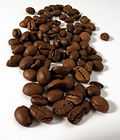Dandelion coffee

Dandelion coffee (also dandelion tea) is herbal tea often used as a coffee substitute (ersatz), made from the root of the dandelion plant. The roasted dandelion root pieces and the beverage have some resemblance to coffee in appearance and taste.
History
Susanna Moodie explained how to prepare dandelion coffee in her memoir of living in Canada, Roughing it in the bush[1] (1852), where she mentions that she had heard of it from an article published in the 1830s in New York Albion by a certain Dr. Harrison. Dandelion coffee was later mentioned in a Harpers New Monthly Magazine story in 1886.[2] In 1919, dandelion root was noted as a source of cheap coffee.[3] It has also been part of edible plant classes dating back at least to the 1970s.[4]
Harvesting

Harvesting dandelion roots requires differentiating 'true' dandelions (Taraxacum spp.) from other yellow daisy-like flowers such as catsear and hawksbeard. True dandelions have a ground-level rosette of deep-toothed leaves and hollow straw-like stems. Large plants that are 3–4 years old, with taproots approximately 0.5 inch (13 mm) in diameter, are harvested for dandelion coffee. These taproots are similar in appearance to pale carrots.
Preparation
After harvesting, the dandelion roots are dried, chopped, and roasted. They are then ground into granules which are steeped in boiling water to produce dandelion coffee.[5]

Benefits
Dandelion coffee is said to be a good tonic for the liver.[6] A bitter tonic made from the dandelion root is also used as a laxative.[7] Dandelion tea is also currently being researched for cancer treatment.[8]
Chemistry
Unroasted Taraxacum officinale (among other dandelion species) root contains:[9]
- Taraxacin[10] (a sesquiterpene guaianolide)
- Phenylpropanoid glycosides
- Phenylpropanoid glycosides: dihydroconiferin, syringin, and dihydrosyringin
- Taraxacoside(a cylated gamma-butyrolactone glycoside) and
- Lactupircin
- Carotenoids
- Esculin
- Scopoletin
- Flavonoids
- Apigenin-7-glucoside
- Luteolin-7-glucoside
- Isorhamnetin 3-glucoside
- Luteolin-7-diglucoside
- Quercetin-7-glucoside
- Quercetin
- Luteolin
- Rutin and
- Chrysoeriol
- Caffeic acid
- Chlorogenic acid
- Chicoric acid (dicaffeoyltartaric acid) and
- ρ-hydroxyphenylacetic acids
- Cyanogenic glycosides
- Sesquiterpene lactones (of the germacranolide type)
- 11β, 13-dihydrolactucin
- Ixerin D
- Ainslioside taraxinic acid
- β-glucopyranosyl
- Taraxinic acid
- Glucosyl ester
- 11-dihydrotaraxinic acid and 13-dihydrotaraxinic acid
- l'-glucoside
- Lactucopicrin
- Lactucin and
- Cichorin
- Eudesmanolides
- Tetrahydroridentin-B
- Taraxacolide-O-β-glucopyranoside
- Prunasin
- Dihydroconiferin
- Syringin
- Dihydrosyringin
- Taraxasterol
- ψ-taraxasterol
- Homo-taraxasterol and
- Stigmatsterol
- Triterpenes
- Cycloartenol
- A Serine proteinase
- Taraxalisin
- α-amyrin
- β-amyrin
- Arnidiol
- Faradiol
- Lupeol
- Taraxol
- Taraxaserol and
- 3β-hydroxylup-18-ene-21-one
- Taraxasterol
- ψ-taraxasterol
- Homo-taraxasterol
- β-sitosterol
- Stigmatsterol and
- Campesterol
- Other
- Lettucenin A and
- Taraxalisin
- Amino acids
- Choline
- Mucilage and
- Pectin
References
- ↑ Moodie, Susanna. Roughing it in the bush. McClelland and Stewart. p. 385. Retrieved 7 July 2011.
- ↑ Whiting, Julia D. (1886-09-01). "The End of a Love Match". Harpers New Monthly Magazine. Retrieved 2008-12-26.
- ↑ "Much of the surpassing cheap brand coffee is made from dandelion root, according to Prof. William Trelease, of the department of botany at the University of Illinois." Jul 6, 1919 p. V13 Los Angeles Times
- ↑ Edible Wild Plants Class to Feature Dandelion Coffee Jun 16, 1977 p. CS8 Los Angeles Times
- ↑ D’Alessandro, Ruth. "Naturenet: Costa Coffee? Free actually (Instructions for making dandelion coffee)". Naturenet. Naturenet. Retrieved 6 April 2014.
- ↑ "dandelion root “coffee” is a good liver tonic" Avoid Christmas hangover Karen McElroy 19 December 2008 The daily.com.au http://www.thedaily.com.au/news/2008/dec/19/avoid-christmas-hangover/
- ↑ "Dandelion". The Columbia Encyclopedia. Columbia University Press. July 2001. Retrieved 2008-12-26.
- ↑ "Dandelion tea touted as possible cancer killer" (Pat Jeflyn/CBC Feb 16, 2012 CBC NEWS http://www.cbc.ca/news/canada/windsor/story/2012/02/16/wdr-dandelion-tea-cancer-killer.html
- ↑ http://webcache.googleusercontent.com/scholar?hl=en&lr=&ie=UTF-8&safe=off&client=opera&q=cache:nZbRBUYUaPsJ:www.phcog.net/reviews/issue3/18.pdf+taraxacin
- ↑ http://pubs.acs.org/doi/abs/10.1021/np990495%2B
| |||||||||||||||||||||||||||||||||||||||||||||||||||||
